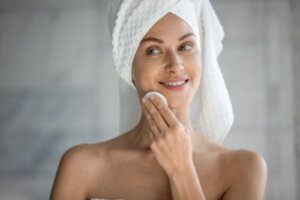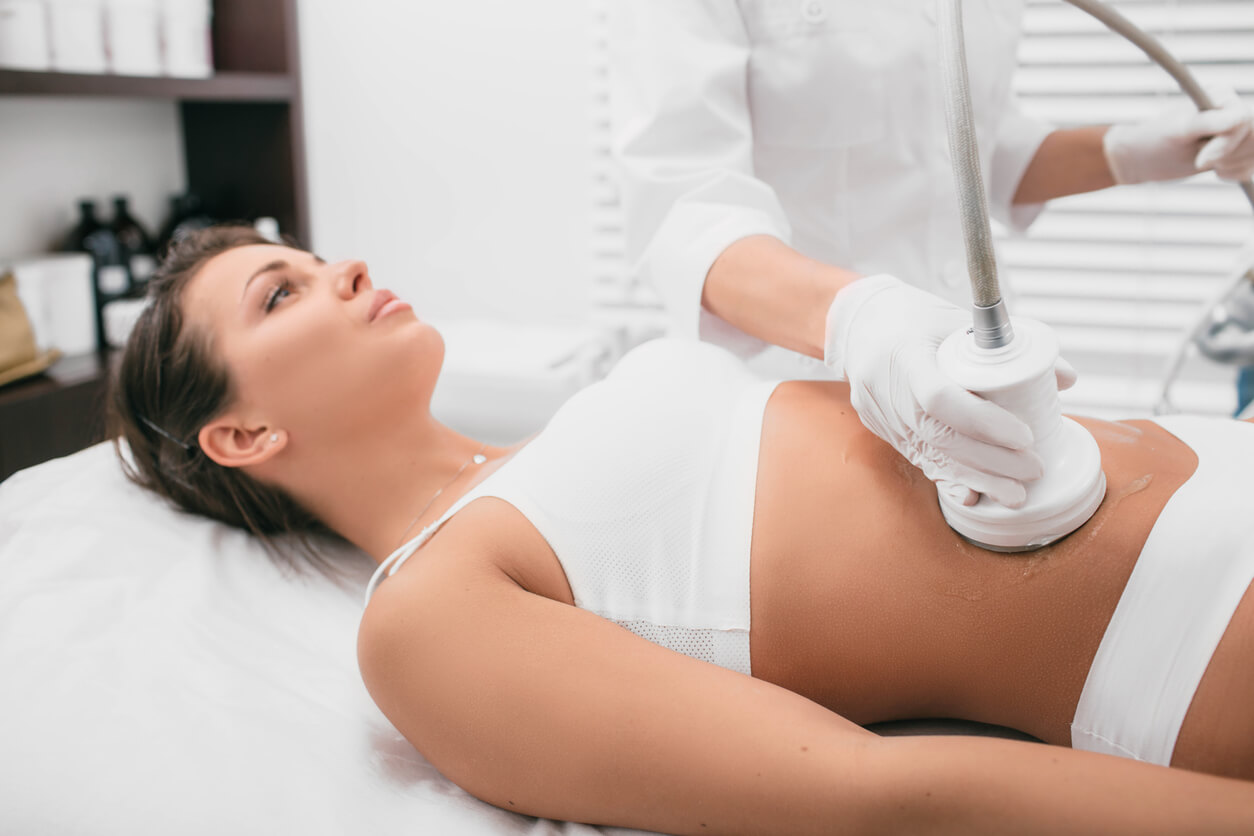Skincare After Childbirth


Written and verified by the dermatologist Maria del Carmen Hernandez
Although during pregnancy, the face looks radiant and smooth, it’s key to practice certain care measures after having your baby. This way, you can treat melasma, redness, acne, and dullness. Keep in mind that, at this stage, progesterone and estrogen levels decrease, which causes some changes to the skin’s surface. Keep reading to find out what skincare after childbirth should involve.
Managing stretch marks
Women often find stretch marks on their bodies after pregnancy, which are generated by weight gain and subsequent weight loss. These may not disappear completely, but they will lighten over time. At first, they’re pink, brown, reddish, or purple in color. This stage requires the least complexity of treatments.
One of the therapeutic options for stretch marks is the application of oils rich in vitamin E and cocoa butter. Also, rosehip oils can be used on areas prone to stretch marks and contribute to their attenuation. They should be used regularly during and after pregnancy to keep the skin of the chest and around the abdomen free of stretch marks.
You may be interested in: 10 Interesting Facts About Your Skin When You’re Pregnant
Cleansing your complexion
Using a gentle cleanser is ideal for both morning and night, followed by a moisturizer and sunscreen. There are also more extensive, multi-step skincare routines. However, the best option is the one that’s performed and maintained over time.
Acne breakouts
Acne breakouts after childbirth are very common due to high progesterone levels. Therefore, they can appear in the form of simple blemishes to more complex acne cases. Consequently, to try to restore the skin’s radiance, it’s best to cleanse the skin in the morning and evening.

Exfoliations at home
Every 15 days, you can implement a skin exfoliation to remove the most superficial cells and boost epidermal renewal. Also, a detoxifying and moisturizing mask can be performed on different nights.
Be careful with physical exfoliants because they can cause small tears on the skin’s surface and be a gateway for bacteria that cause cystic acne.
The depigmentation of pregnancy spots
The best way to prevent or treat pregnancy spots and reduce their severity is to avoid the sun’s rays or protect yourself from them when exposed. Using sunscreen on a daily basis is key to keeping melasma under control and contributing to its diminishment, according to a publication from The American College of Obstetricians and Gynecologists. In addition, mild exfoliants can help with the depigmentation process, as can some products with bleaching agents.
Several options are available for topical management, of which hydroquinone is one of the most commonly used. Other topical agents include the following:
- Azelaic acid
- Kojic acid
- Retinoids
- Topical steroids
- Glycolic acid
Therapy involving a combination of agents is the treatment of choice for decreased potential adverse effects and synergism. In fact, the most popular combination is hydroquinone, a topical steroid, and retinoic acid.
Skin moisturization
In addition to lotions or serums, general moisturization is essential. It makes the surface of the skin more extensible and makes it softer and more supple. In addition, many moisturizers also have a soothing effect on inflamed skin. Even the search for an ideal moisturizer is difficult to achieve because results and needs are subjective.
The use of moisturizers leads to an increase in the water content of the skin’s surface. Also, a smoothing of the skin may be observed as a result of the filling of spaces between desquamated cells. It’s best to opt for a product that’s hypoallergenic, fragrance-free, non-comedogenic, and fast-absorbing.
Read also: A Guide to Beauty Products During Pregnancy

Aesthetic treatments for the skin
In addition to the home skincare practices that are recommended during the postpartum period, there are aesthetic treatments that involve devices. Along with a varied diet, proper hydration, and sports, the following treatments can act as a complementary part of skincare after childbirth:
- Carboxytherapy
- Pressure therapy
- Radiofrequency
- Cavitation
It’s important to wait at least 8 weeks after childbirth to start any of the aesthetic treatments mentioned and three months in case the delivery was by cesarean section. Lymphatic drainage is a good option given its great ability to reduce swelling and edema of the lower limbs.
Skincare and the postpartum period
After pregnancy, stress, fatigue, and hormonal imbalances that produce a change in the texture of the skin surface arise. Some of the most common are hyperpigmentation, stretch marks, and acne. However, through proper skincare after childbirth, along with proper nutrition and hydration, they can be easily resolved.
Although during pregnancy, the face looks radiant and smooth, it’s key to practice certain care measures after having your baby. This way, you can treat melasma, redness, acne, and dullness. Keep in mind that, at this stage, progesterone and estrogen levels decrease, which causes some changes to the skin’s surface. Keep reading to find out what skincare after childbirth should involve.
Managing stretch marks
Women often find stretch marks on their bodies after pregnancy, which are generated by weight gain and subsequent weight loss. These may not disappear completely, but they will lighten over time. At first, they’re pink, brown, reddish, or purple in color. This stage requires the least complexity of treatments.
One of the therapeutic options for stretch marks is the application of oils rich in vitamin E and cocoa butter. Also, rosehip oils can be used on areas prone to stretch marks and contribute to their attenuation. They should be used regularly during and after pregnancy to keep the skin of the chest and around the abdomen free of stretch marks.
You may be interested in: 10 Interesting Facts About Your Skin When You’re Pregnant
Cleansing your complexion
Using a gentle cleanser is ideal for both morning and night, followed by a moisturizer and sunscreen. There are also more extensive, multi-step skincare routines. However, the best option is the one that’s performed and maintained over time.
Acne breakouts
Acne breakouts after childbirth are very common due to high progesterone levels. Therefore, they can appear in the form of simple blemishes to more complex acne cases. Consequently, to try to restore the skin’s radiance, it’s best to cleanse the skin in the morning and evening.

Exfoliations at home
Every 15 days, you can implement a skin exfoliation to remove the most superficial cells and boost epidermal renewal. Also, a detoxifying and moisturizing mask can be performed on different nights.
Be careful with physical exfoliants because they can cause small tears on the skin’s surface and be a gateway for bacteria that cause cystic acne.
The depigmentation of pregnancy spots
The best way to prevent or treat pregnancy spots and reduce their severity is to avoid the sun’s rays or protect yourself from them when exposed. Using sunscreen on a daily basis is key to keeping melasma under control and contributing to its diminishment, according to a publication from The American College of Obstetricians and Gynecologists. In addition, mild exfoliants can help with the depigmentation process, as can some products with bleaching agents.
Several options are available for topical management, of which hydroquinone is one of the most commonly used. Other topical agents include the following:
- Azelaic acid
- Kojic acid
- Retinoids
- Topical steroids
- Glycolic acid
Therapy involving a combination of agents is the treatment of choice for decreased potential adverse effects and synergism. In fact, the most popular combination is hydroquinone, a topical steroid, and retinoic acid.
Skin moisturization
In addition to lotions or serums, general moisturization is essential. It makes the surface of the skin more extensible and makes it softer and more supple. In addition, many moisturizers also have a soothing effect on inflamed skin. Even the search for an ideal moisturizer is difficult to achieve because results and needs are subjective.
The use of moisturizers leads to an increase in the water content of the skin’s surface. Also, a smoothing of the skin may be observed as a result of the filling of spaces between desquamated cells. It’s best to opt for a product that’s hypoallergenic, fragrance-free, non-comedogenic, and fast-absorbing.
Read also: A Guide to Beauty Products During Pregnancy

Aesthetic treatments for the skin
In addition to the home skincare practices that are recommended during the postpartum period, there are aesthetic treatments that involve devices. Along with a varied diet, proper hydration, and sports, the following treatments can act as a complementary part of skincare after childbirth:
- Carboxytherapy
- Pressure therapy
- Radiofrequency
- Cavitation
It’s important to wait at least 8 weeks after childbirth to start any of the aesthetic treatments mentioned and three months in case the delivery was by cesarean section. Lymphatic drainage is a good option given its great ability to reduce swelling and edema of the lower limbs.
Skincare and the postpartum period
After pregnancy, stress, fatigue, and hormonal imbalances that produce a change in the texture of the skin surface arise. Some of the most common are hyperpigmentation, stretch marks, and acne. However, through proper skincare after childbirth, along with proper nutrition and hydration, they can be easily resolved.
All cited sources were thoroughly reviewed by our team to ensure their quality, reliability, currency, and validity. The bibliography of this article was considered reliable and of academic or scientific accuracy.
- Liu DT. Letter: Striae gravidarum. Lancet. 1974 Apr 6;1(7858):625. doi: 10.1016/s0140-6736(74)92681-6. PMID: 4132285.
- Lang, C., Fisher, M., Neisa, A., MacKinnon, L., Kuchta, S., MacPherson, S., Probert, A., & Arbuckle, T. E. (2016). Personal Care Product Use in Pregnancy and the Postpartum Period: Implications for Exposure Assessment. International journal of environmental research and public health, 13(1), 105. https://doi.org/10.3390/ijerph13010105
- Matarasso A, Smith DM. Strategies for Aesthetic Reshaping of the Postpartum Patient. Plast Reconstr Surg. 2015 Aug;136(2):245-257. doi: 10.1097/PRS.0000000000001410. PMID: 26218374.
- van Pelt HP, Juhlin L. Acne conglobata after pregnancy. Acta Derm Venereol. 1999 Mar;79(2):169. doi: 10.1080/000155599750011516. PMID: 10228648.
This text is provided for informational purposes only and does not replace consultation with a professional. If in doubt, consult your specialist.








